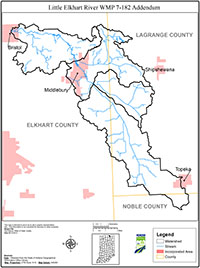Summary
The LaGrange County Soil and Water Conservation District (SWCD) reviewed its water quality improvement efforts across the county to determine areas that need additional focus. The eastern portion contains the “lake country” and has been the center of attention for many years with numerous projects implementing water quality improvement practices designed to reduce non-point source pollution. The western portion of the county has received less attention and that convinced the LaGrange County SWCD staff to focus its next major project in this region of the county. The Little Elkhart River drainage constitutes a major portion of western LaGrange County and was selected as a focal watershed. The Little Elkhart River system presents unique challenges with the preponderance of landowners belonging to the Amish community. Traditionally they have been reluctant to accept federal/state cost-share funds for conservation-based projects. However, the six county Indiana SWCDs that lie within the St. Joseph River Basin had two 319 Grants (administered by LaGrange County SWCD) for Livestock Management within the basin. Since 1999, the livestock specialist working in conjunction with the Natural Resource Conservation Service (NRCS) and SWCD staff has established a close relationship with the Amish community opening the opportunity to develop and implement a long-range, detailed plan for the watershed.
In 2003, the LaGrange SWCD began work on a Watershed Management Plan (WMP) for the headwaters region of the Little Elkhart River. This plan was completed in April 2007 for the 14-digit Hydrologic Unit Code subwatersheds; Bontrager Ditch-Emma Lake (04050001140010), Bontrager Ditch-Hostetler Ditch (04050001140020), and the Little Elkhart River Ditch-Topeka (04050001140030). Although written to stand alone, this plan is essentially an addendum of that initial effort. To fully understand the scope of the project, readers should review the original headwaters WMP which is available at the LaGrange County SWCD.
Building partnerships within the target area and with leadership that influence plan implementation is crucial for WMP success in improving water quality in the Little Elkhart River drainage. As accomplished in the original headwaters region WMP, partnerships were successfully achieved in the remaining four HUC 14s with an aggressive mailing campaign, numerous public meetings, and announcements of the WMP at other county functions, newspaper articles, and one-on-one contacts with landowners residing in the subwatersheds. As a result of the outreach program the public is well aware of the plan, its purpose, and what it can do for them in the quest for cleaner water.
Another aspect that will make implementation of this plan successful is the on-going implementation of the existing WMP for the headwaters region that was completed in April 2007. Under that WMP a paired watershed study, funded by an IDEM 319 Grant and the IDNR Lake and River Enhancement program, the LaGrange SWCD has been very effective in achieving landowner cooperation in implementing best management practices (BMPs) throughout the treatment subwatershed. The outreach program and the aggressive water quality testing data have been instrumental in convincing the Amish community to participate in cost-share programs. To date, 100% of target property landowners have or are in the process of implementing BMPs designed to significantly reduce NPS pollution.

